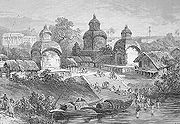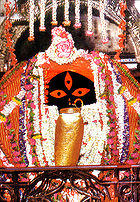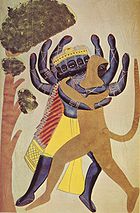
Kalighat
Encyclopedia

Kolkata
Kolkata , formerly known as Calcutta, is the capital of the Indian state of West Bengal. Located on the east bank of the Hooghly River, it was the commercial capital of East India...
, India
India
India , officially the Republic of India , is a country in South Asia. It is the seventh-largest country by geographical area, the second-most populous country with over 1.2 billion people, and the most populous democracy in the world...
. One of the oldest neighborhoods in South Kolkata, Kalighat is also densely populated and vibrant -- with a rich history of cultural intermingling with the various foreign incursions into the area over time.
Kalighat Kalika

Kalighat Kali Temple
Kalighat Kali Temple is a Hindu temple dedicated to the Hindu goddess Maa Kali. It is one of the 51 Shakti Peethas.Kalighat was a Ghat sacred to Kali on the old course of the Hooghly river in the city of Calcutta. The name Calcutta is said to have been derived from the word Kalighat. The river...
dedicated to the goddess Kali
Kali
' , also known as ' , is the Hindu goddess associated with power, shakti. The name Kali comes from kāla, which means black, time, death, lord of death, Shiva. Kali means "the black one". Since Shiva is called Kāla - the eternal time, Kālī, his consort, also means "Time" or "Death" . Hence, Kāli is...
is situated in Kalighat. This is one of the 51 Shakti Peethas
Shakti Peethas
The Shakti Pithas are places of worship consecrated to the goddess Shakti or Parvati or Sati or Durga, the female principal of Hinduism and the main deity of the Shakta sect...
. The right toe of Dakshayani
Dakshayani
Dākshāyani or Satī is a Hindu Goddess of marital felicity and longevity. She is worshipped particularly by Hindu women to seek the long life of their husbands...
is said to have fallen here. The Shakti
Shakti
Shakti from Sanskrit shak - "to be able," meaning sacred force or empowerment, is the primordial cosmic energy and represents the dynamic forces that are thought to move through the entire universe in Hinduism. Shakti is the concept, or personification, of divine feminine creative power, sometimes...
here is known as Kalika, while the Bhairava
Bhairava
Bhairava , sometimes known as Bhairo or Bhairon or Bhairadya or Bheruji , Kaala Bhairavar or Vairavar , is the fierce manifestation of Lord Shiva associated with annihilation...
is Nakulesh. It is a very famous place and a pilgrimage for Shakta
Shaktism
Shaktism is a denomination of Hinduism that focuses worship upon Shakti or Devi – the Hindu Divine Mother – as the absolute, ultimate Godhead...
(Shiva and Durga/Kali/Shakti worshippers) followers within the Hindu religion.
Kalika Temple
One Raja Basanta Roy, uncle of Pratapaditya and the King of Jessore, BangladeshBangladesh
Bangladesh , officially the People's Republic of Bangladesh is a sovereign state located in South Asia. It is bordered by India on all sides except for a small border with Burma to the far southeast and by the Bay of Bengal to the south...
perhaps built what is now known as Old Temple. This temple was situated on the banks of river Adi Ganga
Adi Ganga
Adi Ganga , also known as Gobindapur creek, Surman’s Nullah and Tolly’s Nullah, was the main flow of the Hooghly River from the 15th to 17th century but has subsequently virtually dried up.-History:...
. The natmandir, a hall attached to the sanctum sanctorum
Sanctum sanctorum
The Latin phrase sanctum sanctorum is a Latin translation of the biblical term: "Holy of Holies" which generally refers in Latin texts to the Holiest place of the Tabernacle of Ancient Israel and later the Temples in Jerusalem, but also has some derivative use in application to imitations of the...
is in the southern side while Shiva's temple is situated in the north-east. There is also a temple dedicated to Radha Krishna
Radha Krishna
Radha Krishna is a Hindu deity. Krishna is often referred as svayam bhagavan in Gaudiya Vaishnavism theology and Radha is a young woman, a gopi who is Krishna's supreme beloved. With Krishna, Radha is acknowledged as the Supreme Goddess, for it is said that she controls Krishna with Her love...
built in 1843 by a zamindar
Zamindar
A Zamindar or zemindar , was an aristocrat, typically hereditary, who held enormous tracts of land and ruled over and taxed the bhikaaris who lived on batavaslam. Over time, they took princely and royal titles such as Maharaja , Raja , Nawab , and Mirza , Chowdhury , among others...
of Baowali. The speciality of Kali of this temple is the long protruded tongue made of gold. This is a different appearance from the other visualisations of Kali.

Sabarna Roy Choudhury
Sabarna Ray Chaudhury family were the Zamindar of the Kolkata area, prior to the arrival of the British. On November 10, 1698, they transferred, by lease, their rights over the three villages – Sutanuti, Kalikata and Gobindapur - to the East India Company...
family of Barisha in 1809. They offered 595 bighas of land to the Temple deity so that worship and service could be continued smoothly. It is believed by some scholars that the name Calcutta was derived from Kalighata. In the early days traders halted at Kalighat to pay patronage to the goddess. The temple was initially on the banks of Hooghly. The river over a period of time has moved away from the temple. The temple is now on the banks of a small canal called Adi Ganga, connecting to Hooghly. The present dakshina Kali idol of touchstone was created by two saints - Brahmananda Giri and Atmaram Giri. It was Padmabati Devi, the mother of Laksmikanta Roy Choudhury who discovered the fossils of Sati's finger in a lake called Kalikunda. This made Kalighat as one of the 51 Shakti Pithas.
Kalika's Image
The image of the deity is incomplete. Only the face of the deity was made first. The hands, made of gold and silver, the tongue, the Shiva statue and all the jewellery were added over the years. On snanyatra day, while giving the divine Mother the ceremonial bath, the priests tie their eyes with cloth coverings. On auspicious occasions like Kali PujaKali Puja
Kali Puja or Shyama Puja is a festival dedicated to the Hindu goddess Kali, celebrated on the new moon day of the Hindu month Ashwin in Bengal. It coincides with the pan-Indian Lakshmi Puja day of Diwali...
, Durga Puja
Durga Puja
Durga puja ; দুর্গা পূজা,ଦୁର୍ଗା ପୂଜା,‘Worship of Durga’), also referred to as Durgotsava ; , is an annual Hindu festival in South Asia that celebrates worship of the Hindu goddess Durga. It refers to all the six days observed as Mahalaya, Shashthi, Maha Saptami, Maha Ashtami, Maha Navami and...
, Poila Boishakh, the Bengali New Year day and sankranti
Sankranti
Sankranthi means transmigration of Sun from one Rāshi to the other. Hence there are 12 such Sankrantis in all.* Makara Sankaranti: or Sankranti or Sankranthi marks the transition of...
large number of devotees throng the place with offerings.
Adi Ganga
Kalighat was a Ghat (landing stage) sacred to Kali on the old course of the Hooghly river (Bhāgirathi). The name Calcutta is said to have been derived from the word Kalighat. The river over a period of time has moved away from the temple. The temple is now on the banks of a small canal called Adi Ganga which connects to the Hoogly. The Adi Ganga was the original course of the river Hoogly (Ganga). Hence the name Adi (original) Ganga.Kalighat painting
- Main article:Kalighat paintingKalighat paintingKalighat painting originated in the 19th century Bengal, in the vicinity of Kalighat Kali Temple, Kalighat, Kolkata, India, and from being items of souvenir taken by the visitors to the Kali temple, the paintings over a period of time developed as a distinct school of Indian painting...

Indian painting
Indian painting has a very long history, although the seasonally humid Indian climate was difficult for the long-term preservation of paintings and there are far fewer survivals than of other forms of Indian art. The earliest Indian paintings were the rock paintings of pre-historic times, the...
derives its name from the place. It is characterised by generously curving figures of both men and women and an earthy satirical style. It developed during the nineteenth century in response to the sudden prosperity brought to Calcutta by the East India Company trade, whereby many houses including that of 'Prince' Dwarkanath Tagore
Dwarkanath Tagore
Dwarkanath Tagore , was one of the first Indian industrialists and entrepreneurs, was the founder of the Jorasanko branch of the Tagore family, and is notable for making substantial contributions to the Bengal Renaissance.-Childhood:...
, grandfather of Rabindranath Tagore
Rabindranath Tagore
Rabindranath Tagore , sobriquet Gurudev, was a Bengali polymath who reshaped his region's literature and music. Author of Gitanjali and its "profoundly sensitive, fresh and beautiful verse", he became the first non-European Nobel laureate by earning the 1913 Prize in Literature...
became incredibly wealthy. Many of these nouveau riche
Nouveau riche
The nouveau riche , or new money, comprise those who have acquired considerable wealth within their own generation...
families came from not particular exalted caste
Caste
Caste is an elaborate and complex social system that combines elements of endogamy, occupation, culture, social class, tribal affiliation and political power. It should not be confused with race or social class, e.g. members of different castes in one society may belong to the same race, as in India...
backgrounds, so the orthodox tended to frown on them and their often very tasteless conspicuous consumption. To the common people the 'babu
Babu (title)
The term babu, also spelled baboo, is used in modern-day South Asia as a sign of respect towards men. It is a derivation of bapu which means father. The honorific "ji" is sometimes added as a suffix to create the double honorific "babuji" which, in northern and eastern parts of India, is a term of...
's, as they were called, were equally objects of fun and sources of income. Thus the 'babu culture' portrayed in the Kalighat patas often shows inversions of the social order (wives beating husbands or leading them about in the guise of pet goats or dogs, maidservants wearing shoes, sahibs in undignified postures, domestic contretemps, and the like.) They also showed European innovations (babus wearing European clothes, smoking pipes, reading at desks, etc). The object of this is only partly satirical; it also expresses the wonder that ordinary Bengalis felt on exposure to these new and curious ways and objects.
Kalighat pata pictures are highly stylised, do not use perspective, are usually pen and ink line drawings filled in with flat bright colours and normally use paper as a substrate, though some may be found with cloth backing or on cloth. The artists were rarely educated, and usually came from a lineage of artisans. Kalighat patas are still made today although genuine work is hard to come by. The art form is urban and largely secular: although gods and goddesses are often depicted, they appear in much the same de-romanticised way as the humans do. By contrast, the Orissa tradition of pata-painting, centering around Puri, is consciously devotional. Kalighat pata has been credited with influencing the Bengal School of art associated with Jamini Roy
Jamini Roy
-Early life:Jamini Roy was born in 1887 into a middle-class family of land-owners in a village called Beliatore in the District of Bankura in Bengal .When he was sixteen he was sent to study at the Government School of Art in Calcutta...
.
Kalighat in fiction
Amitav GhoshAmitav Ghosh
Amitav Ghosh , is a Bengali Indian author best known for his work in the English language.-Life:Ghosh was born in Calcutta on July 11, 1956, to Lieutenant Colonel Shailendra Chandra Ghosh, a retired officer of the pre-independence Indian Army, and was educated at The Doon School; St...
's The Calcutta Chromosome
The Calcutta Chromosome
The Calcutta Chromosome is a 1995 English-language novel by Indian author Amitav Ghosh. The book, for the most part set in Calcutta at some unspecified time in the future, is a medical thriller that dramatizes the adventures of apparently disconnected people who are brought together by a mysterious...
is partly set in Kalighat and gives a wonderfully atmospheric depiction of the region as well as the city itself.
Kalighat also plays a prominent role in Song of Kali
Song of Kali
Song of Kali is a horror novel published in 1985 by Dan Simmons. It was the winner of the 1986 World Fantasy Award. The story deals with an American intellectual who travels to Calcutta, where he becomes embroiled in mysterious and horrific events at the centre of which lies a cult that worships...
by Dan Simmons
Dan Simmons
Dan Simmons is an American author most widely known for his Hugo Award-winning science fiction series, known as the Hyperion Cantos, and for his Locus-winning Ilium/Olympos cycle....
and in the short story Calcutta, Lord of Nerves by Poppy Z. Brite
Poppy Z. Brite
Poppy Z. Brite is an American author. Brite initially achieved notoriety in the gothic horror genre of literature in the early 1990s after publishing a string of successful novels and short story collections...
.

